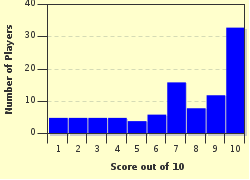Quiz Answer Key and Fun Facts
1. Kuwait's Failaka Island was originally colonized by the Greeks in the 3rd century BC. What did the Greeks call this island? (Hint: feathers, wax, and the sun).
2. Starting in the 16th century, Kuwait was influenced by a variety of European countries, which used Kuwait to develop their trade routes. Which was the first documented European country to use Kuwait for this purpose? (Hint: the name is the base of the Arabic word for 'orange').
3. In the beginning of the 18th century, the British had major control over the trade routes between Europe and Asia. What was the name of the British company that was largest trading company?
4. It is generally accepted that Kuwait officially became a country in 1752, with the appointment of Sheikh Sabah I. When he died in 1762, he was succeeded by whom? (Hint: who would be the most likely candidate?).
5. After a succession of four sheikhs between 1762 and 1892, Sheikh Muhammad Al-Sabah took power in 1892. He only ruled until 1896, when he died. How is he generally believed to have died?
6. Sheikh Mubarak is known as the founder of "modern" Kuwait. Kuwait was small country with a strategic position on the trade routes between India and Europe. Due to increasing instability in surrounding areas, Mubarak sought an agreement of protection from which Europeans? (Hint: they were great colonizers).
7. Sheikh Ahmed Al-Jaber Al-Sabah was the emir of Kuwait when its future wealth was discovered. What was discovered in Kuwait in 1938?
8. Until 1959 Kuwait used the Indian Rupee as its currency, but then the British introduced a new monetary unit, especially for use in the Persian Gulf countries. What was the currency used in Kuwait called from 1959 to 1961? (Hint: where is Kuwait located?).
9. The Kuwaiti Dinar was first set-up in 1961. If the Dinar is equivalent to the US dollar, what is the name of their coin equivalent to the US cent?
10. Kuwait took sides during the Iran-Iraq war of the 1980s. Which side did Kuwait support? (Hint: ironic!)
Source: Author
americanq8ty
This quiz was reviewed by FunTrivia editor
bloomsby before going online.
Any errors found in FunTrivia content are routinely corrected through our feedback system.

